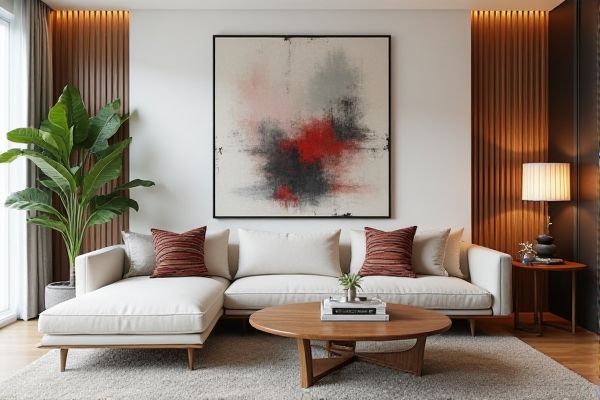
Contemporary art reflects current trends and diverse mediums, often engaging with social and cultural themes, whereas abstract art focuses on non-representational forms, emphasizing color, shape, and texture to evoke emotion. Explore the rest of this article to understand how your appreciation of both styles can deepen through their unique expressions.
Table of Comparison
| Aspect | Contemporary Art | Abstract Art |
|---|---|---|
| Definition | Art created from the late 20th century to present, reflecting current ideas and culture. | Art that uses shapes, colors, and forms to achieve effect without representing reality. |
| Time Period | 1970s to Present | Early 20th Century to Present |
| Style | Diverse, includes various media and approaches, often conceptual. | Non-representational, focuses on visual language like color and form. |
| Subject Matter | Varies widely: social, political, cultural themes. | No direct subject; emphasizes emotions or ideas. |
| Famous Artists | Jeff Koons, Banksy, Yayoi Kusama | Piet Mondrian, Wassily Kandinsky, Jackson Pollock |
| Purpose | Challenge norms, provoke thought, explore new media. | Express feelings, explore color and form relationships. |
Defining Contemporary Art
Contemporary art encompasses diverse styles and mediums created from the late 20th century to the present, reflecting current issues and cultural trends. Unlike abstract art, which emphasizes non-representational forms and shapes, contemporary art often blends realism, abstraction, and conceptual elements to challenge traditional boundaries. Your understanding of contemporary art expands by recognizing its dynamic nature, constantly evolving with societal changes.
Understanding Abstract Art
Abstract art emphasizes non-representational forms, focusing on colors, shapes, and textures to evoke emotions rather than depicting reality. It emerged as a revolutionary movement within contemporary art, challenging traditional perspectives and encouraging viewers to interpret meaning subjectively. Key figures like Wassily Kandinsky and Piet Mondrian pioneered this style, influencing contemporary art's diverse approaches to expression and creativity.
Historical Origins and Evolution
Contemporary art, emerging post-World War II, reflects diverse global perspectives and technological advancements, continuously evolving with social, political, and cultural shifts. Abstract art, originating in the early 20th century with pioneers like Wassily Kandinsky and Piet Mondrian, broke away from representational forms to emphasize color, shape, and form as expressions of emotion and spirituality. The evolution of abstract art laid the foundation for many contemporary artists, blending non-representational techniques with modern themes and multimedia approaches.
Key Characteristics of Contemporary Art
Contemporary art is defined by its diversity and innovation, incorporating a wide range of styles, mediums, and themes that reflect current societal, political, and technological influences. It often challenges traditional boundaries, emphasizing concept over form, and embraces experimentation with new materials and digital techniques. Key characteristics include interdisciplinarity, cultural commentary, and a focus on viewer interaction and interpretation.
Fundamental Elements of Abstract Art
Abstract art fundamentally emphasizes color, shape, and form over representational accuracy, using these elements to evoke emotion and convey ideas beyond literal interpretation. Contemporary art often incorporates diverse media and conceptual frameworks, but abstract art remains distinct in its prioritization of visual language through non-figurative elements. The dynamic interplay of line, texture, and composition in abstract art creates a unique sensory experience that distinguishes it within the broader spectrum of contemporary artistic expression.
Influential Artists in Contemporary Art
Influential artists in contemporary art include figures like Damien Hirst, Yayoi Kusama, and Banksy, whose innovative techniques and provocative themes challenge traditional norms. Their work often intersects with social, political, and technological issues, pushing boundaries beyond abstract art's focus on form and color. Your appreciation of contemporary art deepens by exploring the impactful narratives and diverse media these artists employ.
Pioneers of Abstract Art
Pioneers of abstract art such as Wassily Kandinsky, Piet Mondrian, and Kazimir Malevich revolutionized the art world by emphasizing form, color, and line over representational accuracy. Their work laid the foundation for contemporary art movements by challenging traditional aesthetics and encouraging expressive freedom. This shift towards abstraction influenced diverse contemporary practices, blending innovation with conceptual depth.
Techniques and Mediums Compared
Contemporary art employs a diverse range of techniques and mediums, including digital art, installation, performance, and mixed media, reflecting its expansive and experimental nature. Abstract art primarily focuses on non-representational forms using traditional mediums such as oil painting, acrylics, and sculpture, emphasizing color, shape, and texture to convey emotion and ideas. Both styles push the boundaries of conventional art, but contemporary art integrates innovative technologies and interdisciplinary approaches more extensively.
Impact on Modern Culture
Contemporary art drives modern culture by constantly challenging traditional norms and reflecting current social issues, fostering diverse perspectives and innovation. Abstract art, a key movement within contemporary practices, revolutionized visual expression by emphasizing form and color over representational accuracy, influencing design, fashion, and digital media. Both forms contribute significantly to cultural dialogue, shaping public perception and inspiring creative industries worldwide.
Collecting and Appreciating Both Genres
Collecting contemporary art and abstract art offers unique opportunities to diversify your art portfolio, reflecting both current cultural narratives and pure artistic expression. Contemporary art often captures social issues and innovative techniques, while abstract art emphasizes form, color, and emotion without representational constraints. Appreciating both genres deepens your understanding of evolving artistic trends and the emotional impact of non-representative works.
 homyna.com
homyna.com